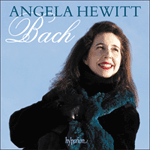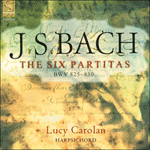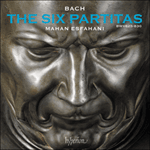The Partita No 3 in A minor is unjustifiably rarely played. Perhaps its opening Fantasia is not considered ‘impressive’ enough. Certainly compared to the opening movements of the other five, it is very unassuming (it is in fact a lovely, easy-flowing two-part invention). It might sound simple, but unexpected turns in the two voices make it tricky to memorize. An elegant Allemande is followed by a vigorous Corrente with perky dotted rhythms and octave leaps. The Sarabande provides a moment of tender repose in an otherwise mostly restless suite. It is a trio of unusual beauty, and I find it easy to imagine two woodwind instruments playing over a continuo bass. In the earlier version of this Partita the Burlesca was entitled Menuet (the music is the same) and there was no Scherzo. These two movements, which should follow in rapid succession, considerably boost the overall energy of the piece and lead straight into the three-part Gigue fugue. Was Bach making fun of the rules of counterpoint when he wrote the descending scale in octaves in the Burlesca? I think it most likely.
from notes by Angela Hewitt © 1997
La Partita nº 3 en la mineur est rarement jouée, et l’on peut se demander pourquoi. Peut-être la fantasia inaugurale n’est-elle pas considérée comme assez «impressionnante». Car elle est certainement très modeste comparée aux mouvements liminaires des cinq autres partitas (il s’agit en fait d’une invention en deux parties, charmante et fluide). Elle peut sembler simple mais des doublés inattendus dans les deux voix la rendent délicate à mémoriser. Une élégante allemande est suivie d’une vigoureuse corrente, dotée de rythmes pointés vifs et de sauts d’octaves. La sarabande procure un mouvement de tendre répit, dans une suite qui est, sinon, essentiellement mouvementée. Le tout forme un trio à la beauté insolite, et j’imagine sans peine deux bois jouant sur une basse continue. Dans la version antérieure de cette partita, la burlesca était intitulée «menuet» (la musique est la même) et il n’y avait pas de scherzo. Ces deux mouvements, qui doivent se succéder rapidement, donnent un élan et une énergie bienvenus à la pièce et conduisent directement à la gigue à trois parties. Bach se jouait-il des règles du contrepoint lorsqu’il écrivit la gamme descendante en octaves de la burlesca? Très probablement.
extrait des notes rédigées par Angela Hewitt © 1997
Français: Hypérion
Die Partita Nr. 3 in a-Moll wird zu Unrecht nur sehr selten gespielt, vielleicht weil ihre eröffnende Fantasie als nicht „eindrucksvoll“ genug betrachtet wird. Sicherlich ist sie im Vergleich zu den Anfangssätzen der anderen fünf Partiten sehr bescheiden (sie ist eigentlich eine liebliche, weichfließende zweiteilige Invention) und mag auch recht simpel erscheinen, doch die eine oder andere unerwartete Wendung in den beiden Stimmen erschwert eine leichte Einprägung des Stückes. Einer eleganten Allemande folgt eine dynamische Courante mit kecken punktierten Rhythmen und Oktavsprüngen, und die Sarabande gewährt uns eine kurze Verschnaufpause im Verlauf einer sonst rastlosen Suite. Dieses Trio ist von ungewöhnlicher Schönheit, und es fällt nicht schwer, sich zwei Holzblasinstrumente vorzustellen, die über der Linie eines Generalbasses spielen. In der früheren Version dieser Partita trug die Burlesque den Titel „Menuett“ (die Musik ist jedoch diesselbe), und es war kein Scherzo vorhanden. Diese zwei Sätze, die rasch aufeinanderfolgen sollten, geben dem Stück als Ganzem einen enormen Energieschub und leiten direkt zur dreiteiligen Gigue-Fuge über. An dieser Stelle stellt sich die Frage, ob sich Bach mit den Kontrapunktregeln einen Scherz erlaubt hat, als er die Abwärts-Oktavtonleitern der Burlesque schrieb. Mir persönlich scheint dies sehr wahrscheinlich.
aus dem Begleittext von Angela Hewitt © 1997
Deutsch: Manuela Hübner


 Bach: Angela Hewitt plays Bach
Bach: Angela Hewitt plays Bach Bach: The Six Partitas
Bach: The Six Partitas Bach: The Six Partitas
Bach: The Six Partitas Bach: The Six Partitas
Bach: The Six Partitas
